Log in or create new account to save this product to your wishlist.

Tips & Ideas for Creating your own Vertical Garden
A vertical garden makes a beautiful addition to an indoor space, but they're equally stunning on a patio or against a sunny wall. Find out more.
🌱 All important maintenance moments for your lawn during the year. Leave your email and we will send you the lawn calendar for free.
Enter your email
Receive the lawn calendar in the mail
Enjoy a green lawn all year round!

- Order by 2PM = shipped today
- 250.000+ satisfied customers!
- 60 day satisfaction guarantee
The vertical garden has become quite the thing over recent years. And it’s not surprising because you can create a beautiful garden wall bristling with green life with some inspiration.
- What is a vertical garden?
- Why is vertical gardening so popular?
- The Benefits of Vertical Gardening
- The Health Benefits of Vertical Gardens
- The Environmental Benefits of Vertical Gardening
- The Economic Benefits of Vertical Gardening
- Planning your Vertical Garden
- Creative Ideas for Designing a Vertical Garden
- Types of Vertical Gardens
- Choosing the right plants for vertical gardening
- How do you make a Vertical Garden?
- How to make an indoor vertical garden
- How to make a vertical garden on a balcony
- How do you mix and match different plants for an amazing effect?
- The materials and tools you’ll need for a vertical garden
- Maintenance tips for a healthy and thriving vertical garden
But how do you create a vertical garden? And is it best to do this inside or out?
In this article, I’ll explain how to create your own vertical garden: what you need to get started and the attention it needs once up and running.
Ready? Let’s get started!
What is a vertical garden?
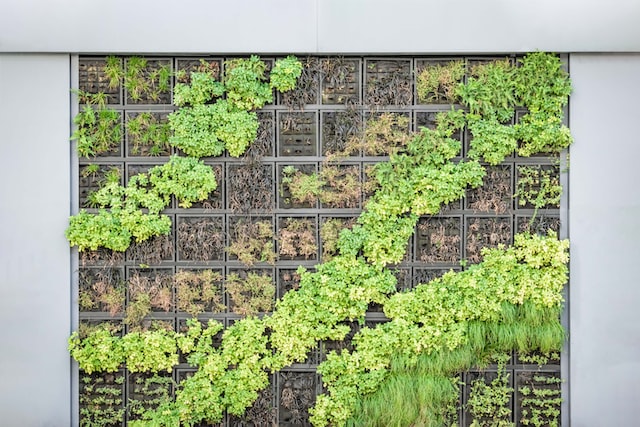
Vertical gardening is the practice of growing plants on walls or other vertical structures. Other names for vertical gardens are green walls or plant walls.
Green walls are popular in the home, bringing life and vitality to indoor spaces, but outdoor vertical gardens are a common feature of gardens in sunny European countries, such as Spain.
So, let’s explore how to transform an unused garden or indoor wall into a budding oasis of life and calm.
Why is vertical gardening so popular?
One of the main reasons for the growing popularity of vertical gardening is the effective use of space. Without taking up any valuable floor space, you can achieve a beautiful, thriving haven of calm by cramming together multiple plants, bringing texture and colour to your indoor or outdoor space.
You’ll find green walls on the outside of residential tower blocks in cities in an attempt to green up city centres. This helps improve the air quality while bringing much needed greenery to concrete jungles.
And while we make every effort to keep moss out of our lawns, moss and fern species make excellent additions to green walls because they require very little maintenance.
You’ll also spot green walls in restaurants and modern office buildings, offering the beauty of plant life and a range of benefits.
The Benefits of Vertical Gardening
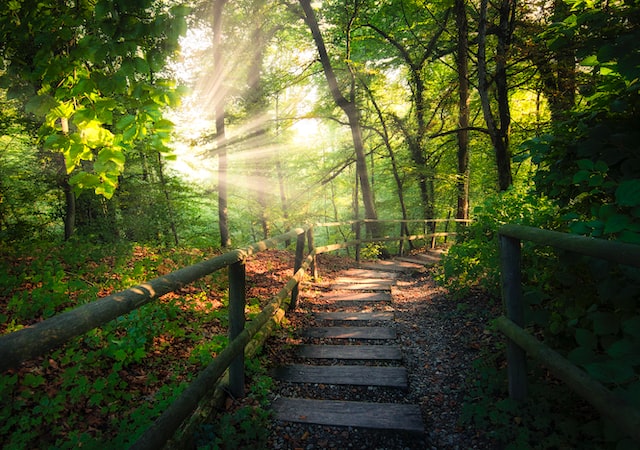
Principally, vertical gardens make optimal use of available space. But living amongst plant life is scientifically proven to improve our mental and physical health, boosting our mood and helping reduce stress levels.
Additionally, living with abundant green life in your home helps clean the air. This is because plants absorb the carbon dioxide we exhale, releasing oxygen back into the room while eliminating harmful airborne toxins.
Green walls are perfect for small or compact spaces, making them ideal for balconies and patios. This is a real boon if you live in an apartment, giving you direct access to green space.
The Health Benefits of Vertical Gardens
While all types of gardening have beneficial effects on your physical and mental health, vertical gardening offers a great sense of satisfaction. Ultimately, the time and energy you put into creating your green wall pay off with a beautiful green space to enjoy.
Studies affirm that gardening is a mindful activity that can help combat depression, whether you’re planting, trimming, pruning, or watering your plants.
Some people even talk to their plants — it’s not as out there as it sounds. When we talk, we release carbon dioxide, so chatting with our plants gives them one of the necessary compounds they require for photosynthesis. And let’s face it — plants never answer back; so they can offer a brilliant way to get things off your chest.
Another health benefit of vertical gardening is the lack of bending or squatting, so it’s better for your back than weeding the garden or mowing the lawn.
Finally, densely packed green walls absorb sound, which helps echoey rooms feel cosier and more welcoming while dampening noise pollution from outside.
The Environmental Benefits of Vertical Gardening
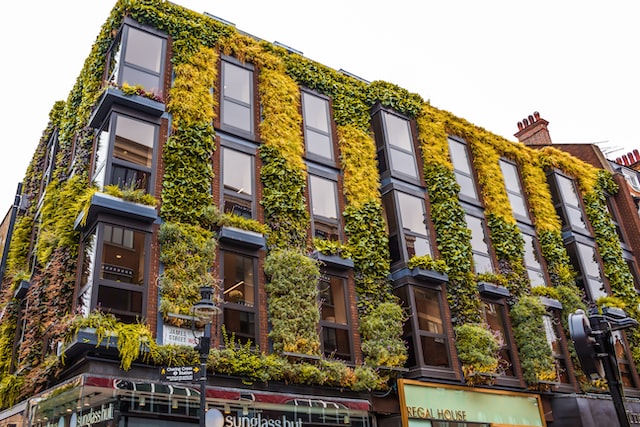
Vertical gardening is a great way to reduce your carbon footprint. They offer an insulating effect, so a densely packed green wall can help save energy.
Additionally, outdoor plant walls help minimise the amount of CO2 in the atmosphere because they absorb this greenhouse gas as part of photosynthesis. And they make a nutritious feasting ground for insects, such as butterflies and bees, so they make a valuable contribution to the biodiversity of your garden and home.
And wherever there’s a plethora of insects, there’s food for birds, so your green wall really is part of the great circle of life.
The Economic Benefits of Vertical Gardening
Vertical gardens can help save energy because they offer insulation for indoor spaces. And outdoor green walls provide shade during the summer, which helps keep your home cool on balmy days. This can help lower your cooling and heating bills.
Remember:
Creating your own vertical garden doesn’t have to be expensive. You can build a beautiful green wall with very little budget. You can even grow some fruit and veg, such as lettuces, tomatoes, and strawberries, on a green wall, helping you save money on your food expenses.
Planning your Vertical Garden
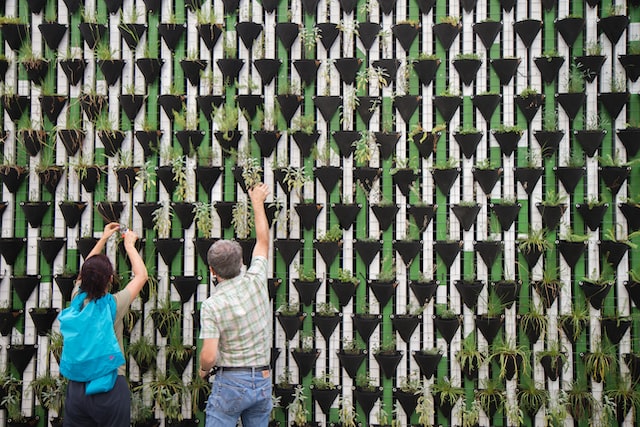
Before you start building your vertical garden, making a plan is a good idea. Start by measuring the wall space and marking out areas for different plants. Leave enough space between the plants, so they have room to grow.
Consider the amount of light you get in your room or the outside spot. This affects the type of plants you can choose. For example, if you’re looking to brighten up a shady wall, choose shade-loving plants, such as ferns, mosses, and ivy.
However, if you have plenty of light, you have more options regarding the plant varieties you can choose from.
Inspect the wall
Before you attach your vertical garden to the wall, make sure it’s in good condition and able to withstand drilling. If you have a fragile wall, consider a free-standing vertical garden, which you can anchor to the wall without drilling.
If you’re using a grid system to build your vertical garden, stretch burlap or felt between the grid and the wall. This will help your plants develop healthy root systems.
Build your own Green Wall Frame
You can buy ready-made vertical garden frames, but they can be expensive.
A cheaper way is to build your own frame from an old pallet or by nailing wooden strips to the wall and attaching pots or hanging plant bags.
Creative Ideas for Designing a Vertical Garden
Once you’ve planned your vertical garden, it’s time to start designing the plant layout. Consider the colours and textures you want, as well as the types of plants you’d like to grow. This is an excellent opportunity to let your creative side sing.
Do you want blooming plants? In which case, you’ll need a sunny spot. If you’re sticking with green, think about how you can mix up the textures — combining mossy plants with fern-like fronds.
You could also add other elements such as statues, birdhouses, bee hotels, or water features — obviously, these ideas are more suited to outdoor green walls.
Types of Vertical Gardens
There are several vertical garden systems available, so take a little time to research which suits your space and needs.
- Vertical shade garden — a collection of closely-packed shade-loving plants, bringing life and vitality to otherwise dingy areas.
- Vertical ornamental garden — gathering together beautiful blooming plants, such as trailing lobelia, fuchsia, begonia. These can be mixed with trailing golden pothos, string of pearls, and staghorn fern. Beautiful!
- Vertical edible garden — growing strawberries, tomatoes,salad leaves, herbs, dwarf beans, even cucumbers and chilli plants. Vertical walls help keep your edibles out of reach of slugs and snails!
- Vertical wild garden — encouraging self-seeding wildflowers and grasses that die off and come back year after year.
- Vertical “quiet” garden — this is where you choose just one type of plant, creating a “zen” effect
Remember, if you’re opting for flowering plants, take the flowering time into account so that you can enjoy blooms all year round.
Choosing the right plants for vertical gardening

Remember, not all plants are suitable for vertical gardening — some plants need more space and don’t do well in containers.
Vertical planters are often smaller than floor-standing containers, so you’ll need to consider this. Also, the more large pots or planters you attach to the wall, the heavier your green wall becomes, so this can be a problem for weak or degraded walls.
Consider plants that will thrive in your local climate and find out the growth characteristics of each plant. Plant trailing plants higher up and ground-dwelling plants at the bottom, but make sure the lower plants can still get access to daylight; otherwise, they’ll die.
The following plant types are perfect for green walls:
- Succulents, such as cactus, jade, and echeveria elegans
- Herbs, such as mint, oregano, and dill
- Fruits and Vegetables, such as tomatoes, radishes, chilis, peppers, and aubergines.
- Flowers, such as spathiphyllum wallisii, leather flower, and laceleaf
- Vines, such as Ivy, clematis, and passionflower
- Creepers, such as Devil’s Ivy, Common Ivy, honeysuckle, and philodendron
The Best Plants for a Shaded Vertical Garden

In general, the following plants do very well in a vertical garden (but make sure you can meet their light requirements!):
- Grasses, such as pyracantha
- Ivy
- Devil’s Ivy
- Spider plants
- Asparagus fern
Plants that do well in a vertical ornamental garden
The following plants offer beautiful colour and spread:
- Violets
- Veronica
- Mask flower
- Bellflower
Remember, houseplants won’t do well outside unless you bring them into the house during the summer.
How do you make a Vertical Garden?
Once you know what type of green wall you’re looking for, you can assemble the frame or trellis. You can buy ready-made frames or build one yourself from wood, metal, or plastic.
Once your vertical garden is set up, the fun part is adding your plants. Fill your planters, baskets, or mounting plates with good quality compost — avoid using common garden soil; it won’t be nutritious enough.
How to make an indoor vertical garden
There are several approaches to making an indoor vertical garden. You may choose to purchase a frame or build your own — either way, choose plants that will thrive indoors.
You could even place plant pots or planters on the floor, with a trellis attached to the wall for creeping.
How to make a vertical garden on a balcony
Again, you could fix a trellis to the wall for creeping plants to grow into, or attach hanging baskets or pot holders to the ceiling or the wall. And while trellises are a little unattractive when you first fix them to the wall, they become a beautiful addition to your balcony once your plants have been established.
How do you mix and match different plants for an amazing effect?

You might want a “quiet” vertical garden, using different varieties of a particular plant species, or you might want to go full maximalist.
For a maximalist approach, mix edible plants and flowers with large blooms with delicately leaved herbs. Consider whether plants will trail or climb, and mix varieties that bloom at different times of the year.
You probably know which plants look lovely in the summer, but some of the best winter flowering plants are:
- Hellebore
- Cyclamen
- Snowdrop
- Winter jasmine
- Winter Aconite
- Camelia
- Crocus
- Mahonia
The materials and tools you’ll need for a vertical garden
If you’re going to garden vertically, there are a few materials and tools you’ll need:
- A frame: frames can be made of wood, metal, or plastic. Purchase them ready-made or customised to fit your space.
- Hanging baskets: look for hanging baskets with metal hooks so they can be hung on a wall or railing.
- Planters: these are your plant’s home, so make sure they’re big enough for its roots.
- Compost: soil is the most important part of any garden. Use a light, well-draining soil; otherwise, the roots could rot.
- Fertiliser: feed your plants regularly — potted plants need extra nutrition to thrive
- Gardening tools: as well as a drill to attach the frame to the wall, you’ll also need a shovel, trowel, and gardening gloves.
Maintenance tips for a healthy and thriving vertical garden
LIke all plants, you’ll need to water and feed your plants regularly. Often, vertical garden pots are smaller than standard plant pots, so your plant will need extra nutrition. Feed your plants with a good quality plant food, such as Babybio, at least once a fortnight for best results.
If your green wall is above an indoor radiator, the soil will dry out more quickly, so make sure you water more regularly. Stick a finger into the soil — if it feels moist, it won’t need water. If it feels dry, give it a drink!
Alternatively, install a watering system, which keeps the soil continuously moist.
Check your plants for pests and diseases — treat them as soon as possible if you spot anything.
Ready to make your vertical garden?
We hope we’ve given you all the information you need to create your very own vertical garden! But if you have questions, don’t hesitate to contact us.
We love hearing from you!
Thanks for reading. And happy vertical gardening!
Before you build your vertical garden, plan your plant choice appropriate to the space. Consider how much light the area receives and choose plants accordingly. Attach your frame to the wall, then fill your trays, pots or planters with good quality potting soil. Simple!
Plants with smaller root systems are most suited to vertical gardens. We recommend ferns, mosses, spider plants, ivy, herbs, tomatoes, and violets. You’ll need to water your green wall more regularly than standard pot plants because they dry out more quickly.
The cost of a vertical garden depends on what you’re looking for. Can you build your own frame from wood, metal, or plastic? Or are you looking for a ready-made frame? DIY frames are, of course, much cheaper but may not look as aestheitcally pleasing as a shop-bought one.
-
How to Grow Eucalyptus in British GardensWith a little love and care, eucalyptus trees can thrive in English gardens. Since they don’t germinate well without proper help, there are not considered invasive. So, there is no reason not to plant them if you enjoy their looks.Read more
-
Transform Your Garden with All-Year-Round Flowering PlantsDid you know you can enjoy blooming flowers even in January? With the right selection of all year round plants, there’s no need to wait until spring to add some colour to your garden.Read more
-
How to Create a Butterfly Garden: A Simple Guide for British GardensThe UK's butterfly population includes 59 different species. These beautiful winged creatures face a steady decline because of habitat loss, pollution and changing weather patterns. Your garden can become a vital link between nature reserves and natural habitats. Let’s explore how.Read more
-
Volcanic Rock Dust for Your Garden—Application and TipsDid you know that volcanic rock dust is a brilliant organic soil improver? This article explains exactly what it's good for and how to use it properly.Read more
-
How to Use Landscape Fabric ProperlyIf weeds or erosion in your garden are troubling you, landscape fabric might be the solution. We’ll explain how and when to use it properly, just keep on reading.Read more
-
Hostas: A Complete Care GuideIf you have a north-facing garden or some shady corners on your property, hostas are the plants for you. These green delights thrive particularly well in partial to full shade and require consistently moist soil to perform at their best.Read more
-
How to Grow Grapes in Your Garden: A Simple Step-by-Step GuideGrapevines produce some tasty fruits, but often they are simply grown for their gorgeous leaves. Whatever your motivation may be, we have a guide on how to grow grapes for you.Read more
-
Worm Composting Made Simple: From Kitchen Scraps to Garden GoldDid you know that a single pound of composting worms can devour half their body weight in waste every day? That's roughly twelve pounds of kitchen scraps transformed into garden gold each month! We will look at how to make this happen.Read more
Leave a comment
Your answer will be displayed on the site and the interested party will be notified by email.
Leave a comment
Have a question or want to share your experience? Leave us a comment.

- Order by 2PM = shipped today
- 250.000+ satisfied customers!
- 60 day satisfaction guarantee

- Order by 2PM = shipped today
- 250.000+ satisfied customers!
- 60 day satisfaction guarantee

- Order by 2PM = shipped today
- 250.000+ satisfied customers!
- 60 day satisfaction guarantee

🌱 All important maintenance moments for your lawn during the year. Leave your email and we will send you the lawn calendar for free.
Enter your email
Receive the lawn calendar in the mail
Enjoy a green lawn all year round!












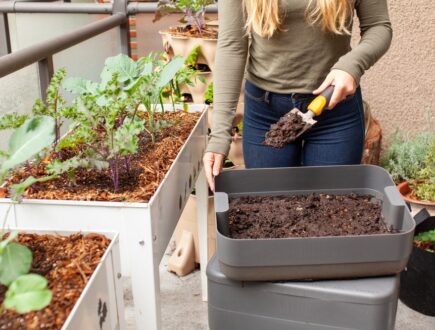








Comments (0)
There are no comments yet. Well then, what are you waiting for to
Be the first to write your comment!inaugurate this pretty page?
Do you have some comments?